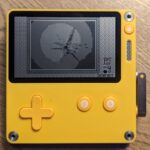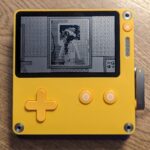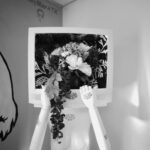ART in Translation across Medium
During development of ART& I was walking through a massive MC Escher exhibit in Houston. So many of his works in black and white seemed like they would translate delightfully into low-res 1-bit, but that would fundamentally change what they are, even while bringing them to a new platform.
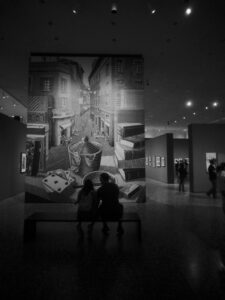
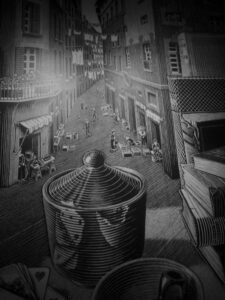
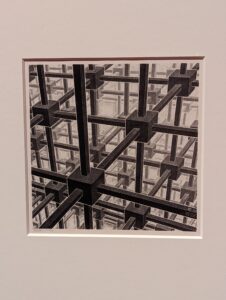
With Escher, the detail and craft embody the message, but there is a loss in translating mediums. The work is fundamentally a different thing even were the artist themselves to craft it. Running through my mind while viewing a master’s work and seeing the arc of his oeuvre was the question: what do we lose in translation and what do we gain?
Market, assuredly. When one’s work can be reproduced and distributed endlessly, it can by definition reach a broader audience. Yet we ascribe much more value to an original or even the giftshop repro than we do, say… a jpeg wallpaper of the same artwork. There is aura in art, like a piece of the soul that clings to the piece in its varied representations.
Other values – educational, cultural, personal – are not easily quantifiable but equally or likely more impactful than the monetary. What is the worth of a statue of old that draws millions of visitors a year to a museum? What does it teach students and what comfort does it give the elderly? What of the painting at the top of your stairs – the one you see everyday? The mural on the corner street? The gifs in a discord conversation?
ART lives with us every day in the big looming pieces, widely known and acknowledged and the little whispers of the wind blowing a candy wrapper in circles right before your eyes. With so many subjects and so Much art around us, what does it mean when one thing becomes another? When the Mona Lisa is sold on a postcard?
There is a spectrum – one end Detail and the other Imagination – and all works fall somewhere between. There is your favorite fantasy book series and its 4k Bluray movie adaptation. We are not here to judge for others their preference, but we certainly hold our own. I contend that the ART itself stands apart from these opinions.
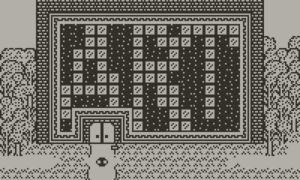
Look at ART&. This gallery and its gameplay are a labor of passion. The value is not necessarily in the money (though I thank you for your purchase!) but in the doing and sharing. Here I’ve shared much of my personal work and a ton of my gameplay concepts and ideas. But these are not final forms or rather, they are their own forms.
They are expressed in the way they need to be for this product which is a vessel of transmission to You. Below are some of the images in the gallery and their originals. I believe that anything presented by an artist as an artwork carries the validity of the creative intention. As the artist behind these, they stand as complete thoughts and only differ by context, audience.
As the maker of these, I do not have a preference for one version or the other. I think they all confer my message which to spell it out, is generally one of Presence. The photos I take are more in the moment than meticulous. I have done the latter, but the former is how I feel most authentic in my work.
—
Often, I enjoy playing with perception and that is perhaps born from a life lived alongside ‘magic eye’ images. When I found them possible in 1-bit and at the scale of the Playdate, it became a topic I Had to explore. There are limitations in their implementation, but not in (I think) their impact.



The images above are the Sunsphere from the 3rd Floor of the Gallery. To the left is the version for Cross view to the right, Parallel view and the underlying shape between. What I found difficult at the scale of the Playdate Pulp engine was, as always, detail. Simple shapes were most effective in my testing which then leaves a gap for the imagination to fill. The impact of either image converging is hopefully highlighted for some in that most of us have a preference for Cross or Parallel view. The market has been heavily weighted for decades towards Parallel, leaving a lot of Cross viewers thinking that they can’t see these. In fact, they just haven’t been popularized for your method of viewing, Cross-viewer. The message has not been crafted for you, and when I learned this, I was sad.
ART is Message and message permeates Translation. Where Detail falls, Imagination grows. Many people have told me they cannot see magic eye, lazy eye, stereograms etc, but in that same breath there is either a wistfulness or a frustration. For some these images loom large in mystery, for others they are spurned as a missive they cannot receive. In an image’s translation from a basic greyscale shape or depth map to the autostereogram, something is lost for a portion of the audience. This is the next layer – that of failure.
Some pieces do not survive translation.
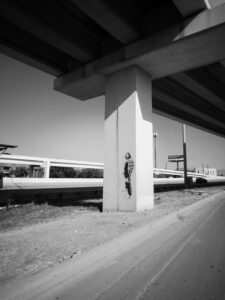
Above is a picture of ‘The Dude’ from The Big Lebowski. This is street art. It no longer exists but in this form, right here. There is a story behind this shot that I want to tell. It does not translate well to this platform. This is the layer of failure, and that not of the person, but of the process. When downscaled and converted for the Playdate, this image and others like it can become unintelligible. The beauty though, in this whole process, is simply that those images are not presented as artwork. They are art-don’t-works in a sense, because the translation blocks the message. In not barreling forward to present these to an audience, I am making an artistic choice and find that silence is its own communication.
We do not need to talk about All things, rather the things that can be conveyed. That is ART. Communication. Missives from one through the moments or the ages to another. What is lost can still be conveyed. It’s a choice and those choices make up the message. We are the interpreters.
–Ledbetter, 2023

